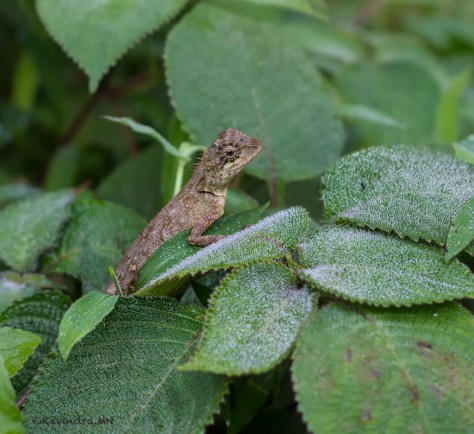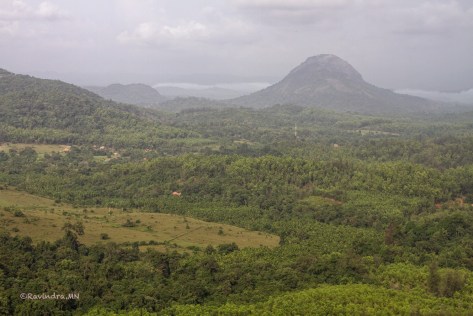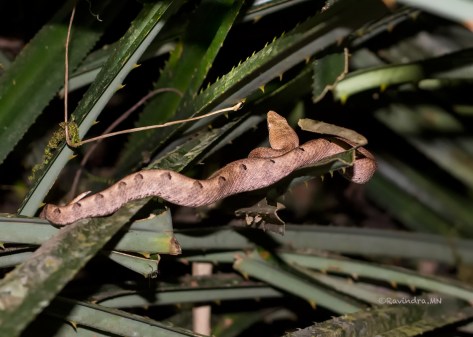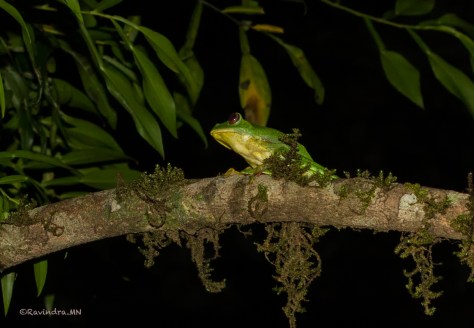Trip: Agumbe
Camp: Kalinga Center for Rainforest Ecology (KCRE)
Dates: 27-29 June ‘14
Who: SS, Dr. R and P. Ramesh (the last figured in my Meghamalai post)
All the pictures used in this post were shot by Dr. R.
This trip was different from our usual ones, as none of us had ever tried a herp outing before. It was put together for us by Ficus, and they did a pretty good job of it, taking care of all reservations and transfers efficiently and courteously. We stayed at Kalinga for two nights and three days. The camp was very basic with tented acco and a wash-your-own-plate policy, but we had a delightful time nonetheless. The rough-and-ready ambience didn’t extend to the loos though – the toilets were spic and span, with rustic red oxide flooring, something many of us hadn’t seen in years. The camp was managed by Prashant and had a couple of interns pursuing research – Sonu Soman and Udit Singh Chauhan, and all three went out of their way to make sure we were kept comfortable and entertained.
We took the slow train from Bangalore, the Karwar express that covered the 400+ kilometers to Udupi in an agonizing fourteen hours. That translates to an average speed of less than 30 kmph, though the actual distance the train covered was more considering that it wound its way via Mysore. Driving down was possibly a better option. From Udupi, we back-tracked by road to KCRE, a distance of about sixty kilometers. The road is motorable until a short distance from the camp and the short walk down the path into it is a great opportunity to make your first acquaintance with the leech.
Prior to the trip, we had been warned to expect heavy rains and millions of leeches. The former didn’t show and while Bangalore was experiencing heavy showers, Agumbe remained rainless. The leeches didn’t disappoint though. They were everywhere, millions of ‘em.
Shortly after settling in, we made our first foray around the camp and were instantly rewarded. There was a Malabar pit viper – Trimeresurus malabaricus – a foot off the ground on a wild turmeric plant right outside the bathroom building. And a green vine snake on some shrubbery near the dining area.
Green vine snake:
By the path leading out of the camp was a mating pair of Malabar pit vipers, under 24-hour surveillance by the interns who endured much hardship to record data around courtship rituals and the mating act. Sonu and Udit were running shifts almost round the clock, taking turns to sit by the mostly inactive pair.
Mating pair of Malabar pit vipers; the male is the smaller individual:
There are four trails that radiate out from the KCRE camp, and we did the stream trail in the evening. The trail was pretty enough, winding its way through areca plantation and evergreen forest, alongside the little stream that flows beside the camp. We didn’t see any snakes on that outing, but we did see a bunch of amphibians. Roux’s forest lizard (Calotes rouxii), Minervarya sp., Skittering frog (and tadpole), the endemic Bicolored frog (Clinotarsus curtipes), Tiger toad and another endemic – the Reddish burrowing frog (Zakerana rufescens).
Roux’s forest lizard:
Minervarya Sp.:
Bicolored frog:
And a bunch of bugs and spiders. Lantern bugs, Tiger beetles, Water spiders, Two-horned spiders and a rather reclusive Tarantula. I should mention that Udit, the intern who guided our trails did a spectacular job of spotting and identifying critters none of us would have otherwise noticed.
Night times at the KCRE camp are noisy. If the day belongs to the cicadas acoustically, the night belongs to a bunch of other equally vocal critters. Most noteworthy of which was a creature which produced a clear-toned, two-note whistle very reminiscent of birdsong. It was loud, distinctive and ubiquitous. Naturally, we were intrigued. Turned out it wasn’t a bird after all, but a bush-cricket or Katydid – Holochlora albida. Sonu clarified this, showed us a picture he had clicked, and then rummaged through an entomology book the next day to produce the identification. We saw the actual culprit on the night walk the next evening. There were also plenty of fireflies around, lighting up the night with their little lanterns.
There is a small bamboo platform in the forest a little above the camp that provides a nice, secluded camping site. Prashant was willing to pitch tents for us there if we wanted it, but a quick inspection showed the path to be packed with wet mud and leeches and we opted to stay down in the camp tents.
Early next morning, we walked over to the grassland area that is a kilometer or so from the camp. This is a beautiful area when the weather is pleasant, and it was brilliant that morning – cloudy, cool and breezy. We saw a Hump-nosed pit viper (Hypnale sp.) by the path a short way from the camp, and the day was starting to look good. Our plan was to do a couple of hours of birding along the edge of the grassland patch, and we netted a small bunch of the usual suspects. Yellow-wattled lapwing, Red-wattled lapwing, Crested serpent eagle, Red vented bulbul, Red whiskered bulbul, a solitary White ibis, Gold-fronted leaf bird, Flame-throated bulbul, Vernal hanging parrot, Orange minivet, Asian fairy bluebird, and White-cheeked barbet. And a bird none of us could identify, which Messrs Grimmett and Inskipp kindly identified for us later at the camp as the Grey-headed bulbul – a Western Ghats endemic. And on the way back, we ran into a juvenile Beddome’s keelback (Amphiesma beddomei) as it frantically slithered off the path and out of our way.
Bull frog:
Breakfast done, we were entertained by Draco Dussumieri – the Southern flying lizard. There was Draco action all afternoon as the little dragons constantly flitted between the Areca boles in the camp. We learned this was not typical at this time of year. Prashant also unearthed a Caecilian to show us – a fossorial amphibian that superficially resembles a snake or earthworm.
In the late afternoon, we took another trail to a nearby peak with a mouthful of a name – Akki Battha Rashi Gudda. The trail involved stiff climbs on some stretches, though the view from the summit more than compensated for the sweaty effort.
We saw Fejervaria sahyadris and bush frogs en route, and a Malabar pit viper on a bush beside the path on the way back.
Malabar pit viper:
We wanted to experience a night walk, and Prashant and Udit obliged us by taking us out some distance on the driveway. We saw three snakes – a Malabar pit viper and a vine snake that we passed by the next day too a couple of times, a Hump-nosed pit viper, Yellow bush frogs and another local celebrity – the endemic Malabar gliding frog (Rhacophorus malabaricus).
Hump-nosed pit viper:
Malabar pit viper:
Malabar gliding frog:
Yellow bush frog:
We repeated the trip to the grassland the next morning, though the weather was not quite as pleasant as on the previous day. The sun was out and we were all tanned three shades darker. In addition to the previous day’s avians, we saw several Malabar grey hornbills, Malabar parakeets, White-bellied treepies, Racket trailed drongos, Common Ioras, Bronzed drongos, Loten’s sunbird, a flowerpecker and two endemics that we identified back at camp with some help from Prashant – Malabar lark and Crimson-fronted barbet.
Being newbies to herping, we had requested Ficus and Prashant for a short classroom orientation session. Sonu and Udit did a masterful job of taking us through the basics of snake evolution, local species, snake identification, taxonomy and snake-bite handling. The session culminated with an informal test of our snake identification ability by having us study moults against a handbook to try and identify the species.












